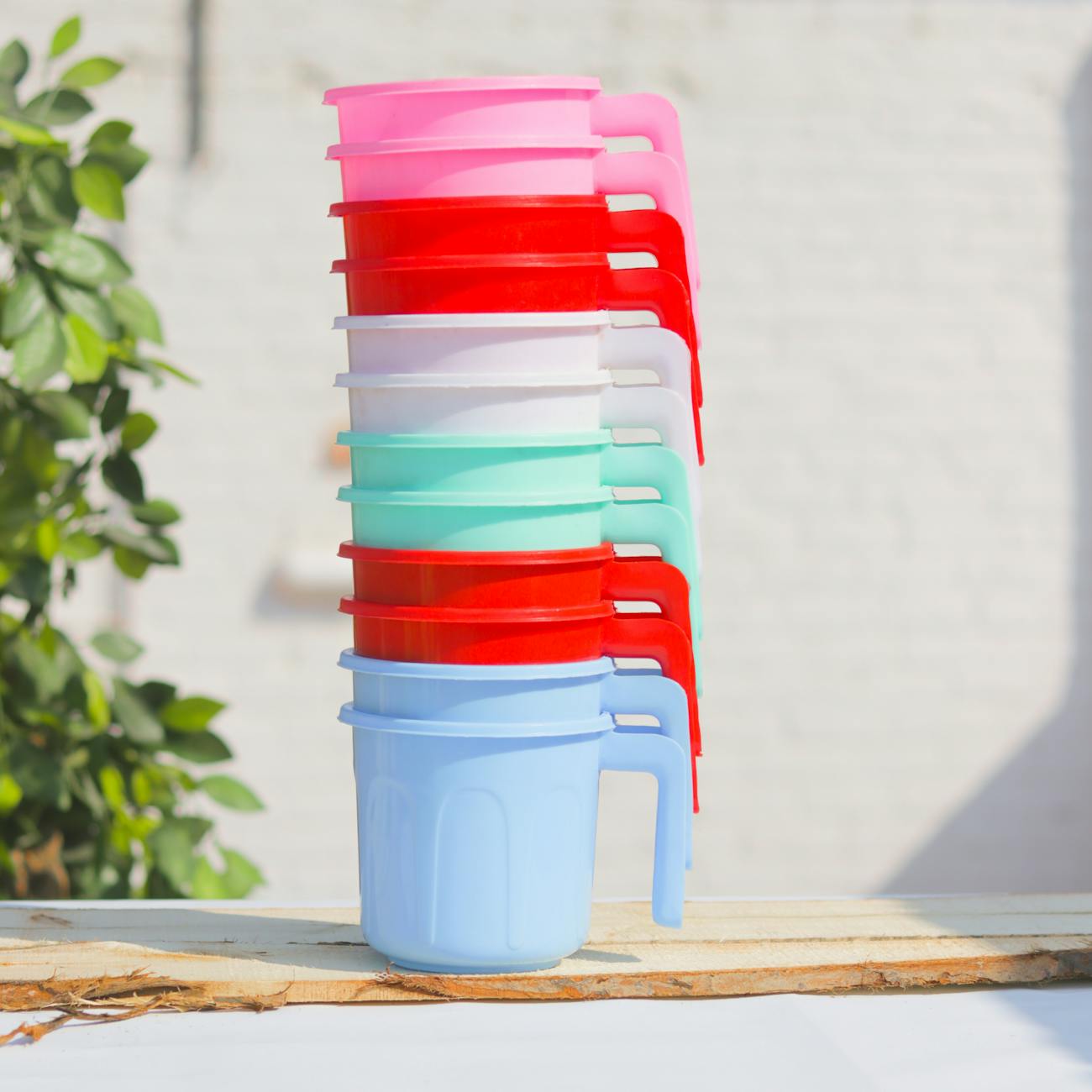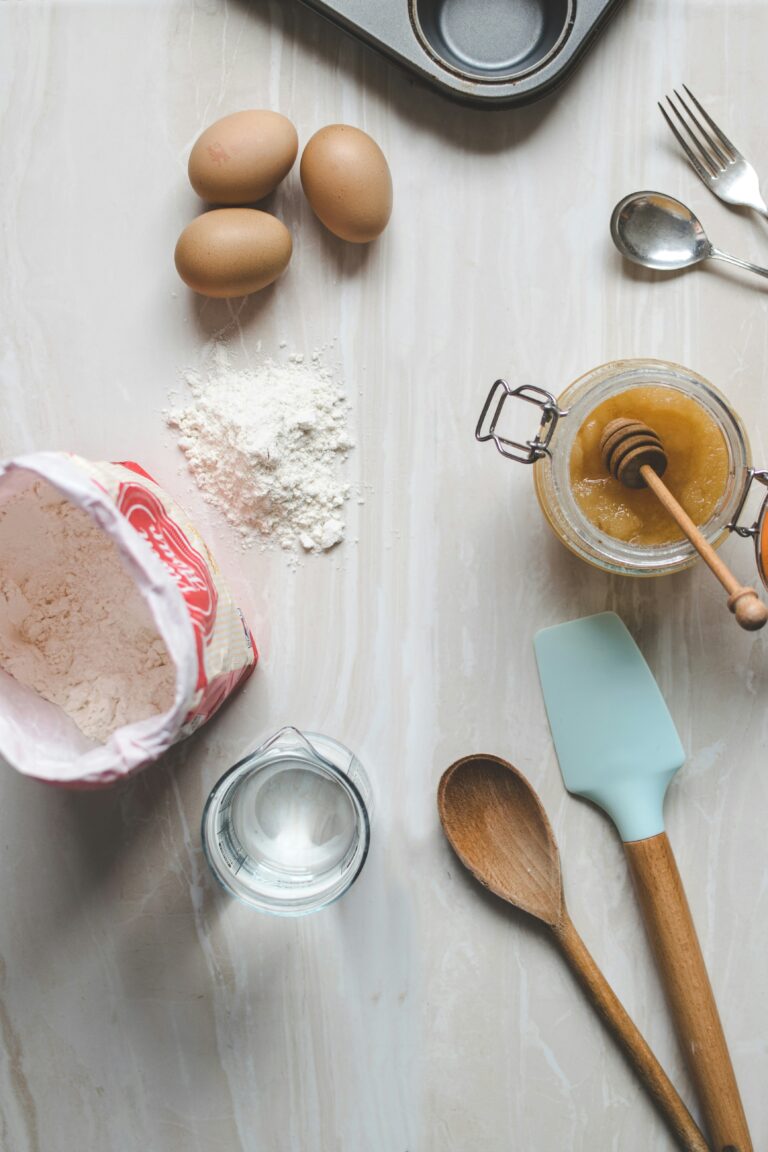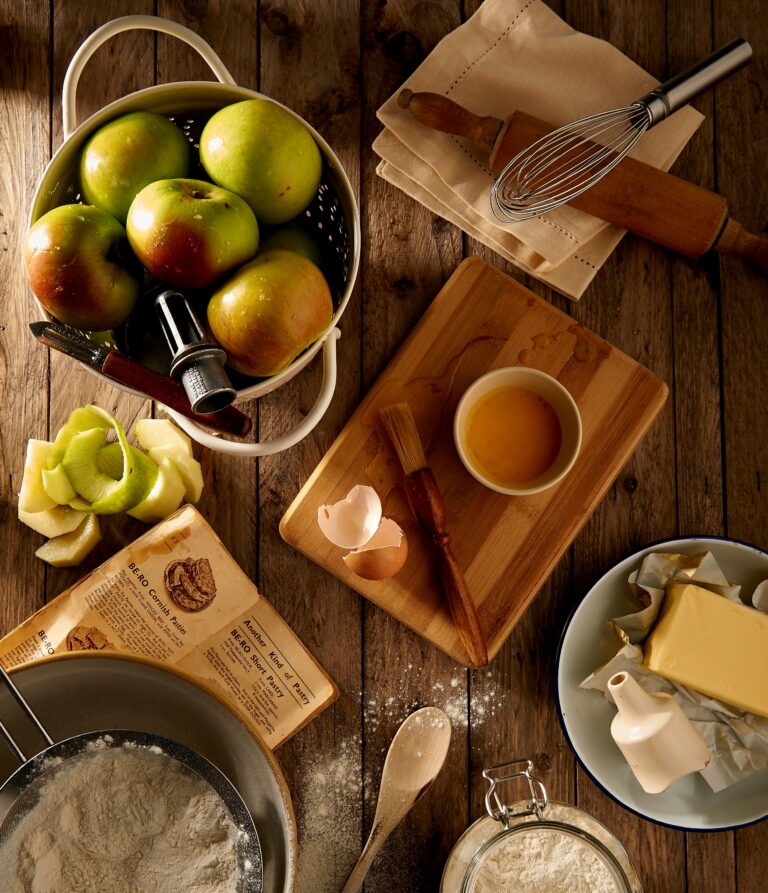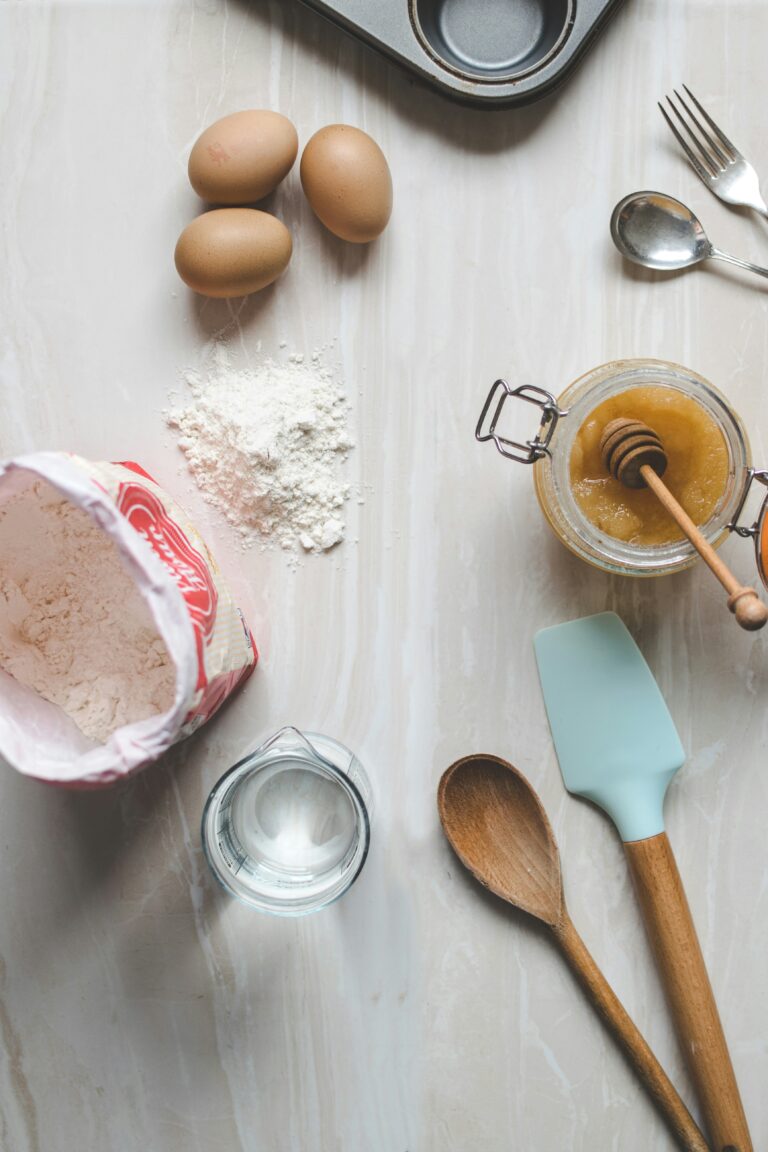The Importance of Accurate Measurements in Baking
Nailing those measurements when baking ain’t just about keeping Grandma’s cookie recipe alive; it’s the secret sauce to baking success. Mix up proportions, and you’re asking for a cake that resembles a pancake or cookies that spread like gossip at a family reunion. The unsung hero in this tale? Those trusty dry measuring cups.
Precision in Baking
Cooking’s more of a jazz solo, baking’s a strict concert recital. Toss in ingredients like you’re free-styling, and you might end up with muffins suitable only for self-defense. The magic in baking is all in getting the amounts just right. A sprinkle too much or too little has a domino effect – affecting texture, taste, and even the color of your treat. So, if you want cookies that don’t bite back or bread that’s not more hole than bun, stick with precise measurements.
Role of Dry Measuring Cups
Dry measuring cups are like your baking sidekicks. Built specifically for the job, they’re the go-to for handling things like flour, sugar, or cocoa powder. And no, using liquid measuring cups is not an acceptable substitute – imagine trying to pour flour! Different sizes, marked amounts, you get the gist; they’re the Swiss army knife in every baker’s toolkit.
Handling these cups ain’t a guessing game either. Don’t go all in and scoop directly from the bag – that’s just asking for a flour explosion. Instead, gently spoon in your flour or sugar, then swipe a flat edge across the top to level it out. No mountains or craters allowed here.
Depend on these tools, and you’re setting yourself up for baking greatness. Whether you’re a beginner or a seasoned pro, mastering your measure game is crucial. From basic utensils to digital scales, our gadgets make sure we’re not fudging the numbers and help bring our baking magic to life.
Baking is part art, part science, and understanding the role of these trusty measuring cups is the key to unlocking an endless treasury of mouth-watering treats. So gear up, stay precise, and let’s bake like we mean it!
Understanding Dry Measuring Cups
When we’re mixing up a storm in our kitchens, the right tools can make all the difference. Dry measuring cups might seem ordinary, but mastering their usage is key to ensuring our recipes turn out just right.
Design and Functionality
Dry measuring cups are our go-to for ingredients like flour, sugar, and grains. Unlike their liquid counterparts with spouts, these cups boast a flat edge that’s perfect for leveling ingredients. This thoughtful design ensures we’re getting the most precise scoop every time. Sizes vary, giving us the freedom to measure different amounts with ease.
Many of these cups have flat bottoms, so they can sit snug on the counter. That makes it a breeze to fill them up without making a mess. And the comfy handles? They’re there to make carrying and pouring a cinch.
Sizes and Variations
You’ll find dry measuring cups in various sizes, ready for any culinary adventure. The usual suspects are 1 cup, 1/2 cup, 1/3 cup, and 1/4 cup. These allow us to switch gears without switching tools and match whatever a recipe throws our way.
For those hefty recipes, some sets come with biggies like 2 cups or more. And here’s a clever twist: nested cups. They stack into one another, saving space and headaches when it’s time to tidy up.
Grasping how our trusty dry measuring cups work can make a world of difference in baking. By getting cozy with these essential tools, we bring our A-game to every dessert and elevate our culinary adventures. Want more scoop on other must-have baking gadgets? Be sure to peek at our article on measuring tools for baking.
Types of Dry Measuring Cups
Ah, measuring cups! The unsung heroes of our kitchen escapades, these trusty sidekicks play a pivotal part in ensuring our dishes turn out just right. So, what kinds do we have hanging around in our kitchen drawers, eager to help us measure flour for that perfect cake or sugar for sweet cookies?
Stainless Steel Cups
Let’s start with the mighty stainless steel cups. These bad boys are the tanks of the measuring cup world, sturdy and built to last. They laugh in the face of scratches and will outlast even the most spirited baking marathons. Thanks to the etched or engraved measurement marks, you won’t see them fading away any time soon.
Plus, heat? Not a problem here. Melt some butter or chocolate – these cups can handle it without breaking a sweat. And guess what? They’re a breeze to clean and are usually dishwasher friendly, too. So, not only are they practical, but they also cut down on cleanup time. Double win!
Plastic Cups
If you’re looking for something budget-friendly and as colorful as your grandma’s candy jar, check out plastic measuring cups. Light as a feather and available in tons of shades and patterns, they bring a splash of fun to your baking adventures.
Just a heads-up, though: they’re not as heat-friendly as their stainless steel pals. Stick to room temp or cooler ingredients to keep them from getting warped. But don’t worry if life happens – they’re cheap and easy to replace, so no harm done.
Nested Cups
Now, who doesn’t love a good space-saving trick? Nested measuring cups fit inside one another like those Russian dolls, making them a prime choice for anyone looking to tidy up their kitchen clutter. They come in a variety of sizes, from a little 1/4 cup to a full 1 cup, offering everything you need in one neat package.
This design is perfect if you’re tackling a recipe that calls for various measurements. No digging around needed – they’re all right there, stacked and ready for action. So, when your bread recipe demands a dash of precision, you’re all set.
By getting acquainted with the stainless steel, plastic, and nested measuring cups, you’ll be better equipped to choose one that vibes with your style from the get-go. Each comes with its perks, tailored to different needs in your glorious kitchen adventures. Quality measures mean better results, and that means tastier treats for all.
Choosing the Right Dry Measuring Cups
Picking the perfect dry measuring cups for baking is more than just grabbing what’s on sale. It’s about getting tools that make sure your recipes don’t flop. So, let’s chat about what matters when you’re on the hunt for that ideal set.
Considerations for Selection
-
Material: Dry measuring cups usually come in stainless steel, plastic, and sometimes glass. Stainless steel ones are like the tanks of the kitchen; they won’t rust and can handle a beating. Plastic cups, on the other hand, are super light and sometimes look like a rainbow parade. Think about which material works best for you.
-
Durability: You want measuring cups that aren’t gonna bail on you after a few uses. Go for ones with solid handles and markings that don’t fade away like a bad tan line.
-
Nesting Feature: Ever feel like kitchen cupboards are a black hole? Nesting cups stack together nice and tidy. They save that precious space and keep your measuring set easy to grab.
-
Measurement Markings: Make sure your cups have markings that even a sleepy morning brain can read. Look for ones that show both cups/ounces and milliliters/grams. It’s all about being ready for any recipe that comes your way.
Factors to Evaluate
Here’s a peek at what to think about when picking dry measuring cups:
| Factors to Evaluate | Description |
|---|---|
| Material | Stainless steel for long-lasting toughness or plastic for light as a feather use. |
| Durability | Solid cups with strong handles and stay-put measurement lines. |
| Nesting Feature | Space-saving cups that fit together like puzzle pieces. |
| Measurement Markings | Easy-to-see markings in both US and metric units. |
When you pause to mull over these points, you can snag a set of measuring cups that are reliable and ready for any baking adventure. If you’re curious about other baking tools, swing by our full guide on measuring tools for baking.
Proper Usage of Dry Measuring Cups
Baking’s a bit like chemistry class with cookies—exact measurements are everything. Let’s chat about how to make sure your dry measuring cups help you nail those recipes every time.
The Right Way to Measure
For those classic dry ingredients like flour, sugar, or cocoa powder, here’s the game plan:
- Go for the Spoon & Level: Grab a spoon and gently fill your measuring cup with the ingredient, letting it heap up a bit above the rim. No need to pack it in tight like you’re crushing ice for a summer drink.
- Smooth It Out: Use something flat like a knife or spatula to swipe away the extra on top, leaving you with a level and honest measurement.
The trick here is to spoon ingredients into the cup, not scoop them out straight from the bag. Seriously, if you scoop it like ice cream, everything’s going to get squished and you’ll end needing more ingredients than you should. Your cakes and cookies will thank you for keeping things light and precise.
Leveling the Ingredients Like a Pro
After filling the cup, here’s the lowdown on getting that level measurement perfect:
- Hold Tight: Keep a good grip on the cup—you don’t want it slipping away just when you’re getting things right!
- Slice the Peak: With your trusty flat-edged pal, move across the top and get those mounds of excess out of there. Think of it as giving a mini haircut.
Getting your measurements spot-on is not just about boss-level bragging rights—it actually impacts the taste and texture of those goodies you’re baking. Whether it’s that flour or granules of sugar, keeping measurements precise keeps recipients begging for more without even knowing why. Need more tips to measure flour like a pro? Check out our how-to article.
By perfecting these simple steps to measure and level your dry ingredients, you’ll bake like a champ, bringing your kitchen creations to consistent perfection. Accurate measurements? That’s where baking magic begins, my friends.
Keeping Dry Measuring Cups in Great Shape
To make sure your baking masterpieces aren’t more “oops” than “wow,” take care of those trusty dry measuring cups. With a few basic tricks for cleaning and stashing them away, you’ll keep them in tip-top shape and your recipes will keep coming out just right.
Cleaning and Care Tips
Giving your dry measuring cups a good scrub after each use is a must to keep flavors from playing hide and seek in your next batch of goodies. Here’s how to keep them in the best shape:
| Tip | Description |
|---|---|
| Hand Washing | Skip tossing these cups in the dishwasher; those cleaners can be rough. Give them a gentle wash by hand with some mild soap and warm water. |
| Dry Thoroughly | Be sure they’re bone-dry before putting them away to ward off rust or that pesky corrosion. |
| Removing Stains | Got some stubborn gunk? Mix up a little baking soda and water paste. Use a soft sponge to lovingly scrub away the trouble spots. |
Stick to these cleaning habits to keep your measuring cups from sharing unwanted flavors with your ingredients and to keep them working for you longer.
Storing Dry Measuring Cups
Keeping your measuring cups happy also means storing them where they won’t get lost in the kitchen clutter. Here’s how:
| Tip | Description |
|---|---|
| Nesting | If your cups nest like Russian dolls, stack ’em up according to size for a neat stash and to avoid losing one. |
| Hanging | Hooks or a rack in your kitchen can save space and make ’em easy to grab when the baking bug bites. |
| Dedicated Space | Give them their own drawer or container so they don’t get lost among the spatulas and whisks. |
With a smart place for storage, you’ll keep your cups from disappearing and have them ready to jump in whenever you get the urge to bake.
Taking care of your dry measuring cups by giving them a good clean and a smart stash spot is a fuss-free way to keep your baking as precise as a pro chef. These little steps will help you whip up consistently tasty treats and make every bake feel like a win! Happy baking!
Using Dry Measuring Cups in Recipes
Alright folks, let’s talk baking. You know, that special magic where ingredients come together to create sugary, fluffy wonders. And trust us, getting those measurements right is the secret sauce—or, you know, secret flour. Here, we’ll walk you through how to wield those dry measuring cups like a pro and even throw in a few tips on conversions when the recipe is written in a language you don’t speak (we’re looking at you, metric system).
Common Baking Measurements
Your kitchen should never be without those trusty dry measuring cups. They’re your best buds when it comes to mixing up flour, sugar, oats, or anything that’s not marketable pre-packaged as cake mix. Knowing the basic weight conversions for these ingredients makes playing with recipes a whole lot easier, and we’ll help ya out with a few here:
| Ingredient | 1 Cup | 1/2 Cup | 1/3 Cup | 1/4 Cup |
|---|---|---|---|---|
| All-Purpose Flour | 120g | 60g | 40g | 30g |
| Granulated Sugar | 200g | 100g | 67g | 50g |
| Brown Sugar (packed) | 220g | 110g | 73g | 55g |
| Rolled Oats | 90g | 45g | 30g | 22.5g |
Getting these measurements down is a key move if you want your baked goodies to come out consistently awesome. And if you wanna know how to nail flour quantities specifically, pop over to our other article on how to measure flour for baking —trust us, it’s a baker’s game-changer.
Converting Measurements if Needed
Sometimes, recipes just love throwing curveballs with their different units. Don’t sweat it! Grabbing a baking measurement conversion chart or an online tool is your best bet when your recipe starts speaking in milliliters or grams.
If you ever find yourself needing to shift dry ingredient measurements from cups to grams or ounces, those charts are a lifesaver. Plus, if you’re the type who prefers the accuracy of working with weights, a metric chart is what you need to swap around units effectively.
But a word to the wise: staying accurate with conversions keeps your desserts from falling flat—literally. Using precise measuring tools like digital scales can be the difference between decadent and deflated. For brainless conversions, don’t forget about our baking measurement conversion calculator.
In the world of baking, knowing your way around measurements—even the trickiest conversions—can seriously ramp up your kitchen game. So grab those dry measuring cups, channel your inner baker, and create some tasty treats with just the right amount of confidence and creativity. You got this!





